Tsushima battle. What did Z.P. Rozhdestvensky, dividing the forces into two columns?
As we said earlier, in the morning of May 14, the Russian ships retained the marching line, but then undertook a number of difficult-to-explain maneuvers: they lined up in the wake line, tried to build a front line with part of the forces, but instead collapsed into two columns, etc. Why ZP Rozhestvensky made such confusion with rebuilding the squadron in battle order?
Two words about combat constructions
To begin with, we recall a few alphabetical, in general, truths.
The first. As we know, at that time there were three main combat systems: the wake column, as well as the front and bearing.
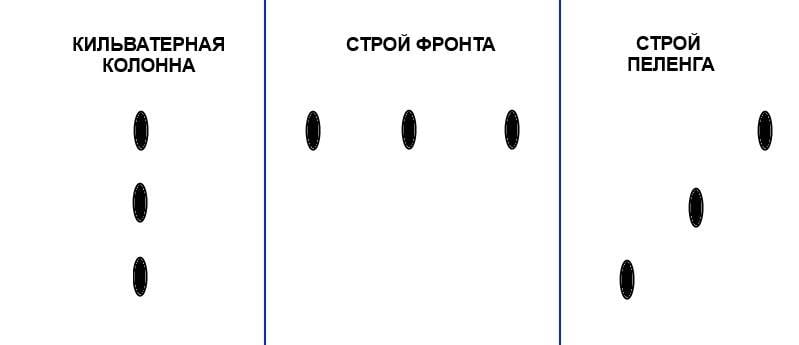
In this case, the last two in real combat clashes were used quite rarely, the main construction was the wake column. Admirals' commitment to the wake column is explained by the fact that with such a construction, the flagship warship provides maximum visibility, and simple maneuvers (turns in series) can be performed without raising the signals, according to the principle “do as I am”.
The second. During combat maneuvering the length of the system was of great importance. Thus, the 12 armored ships of the Russian squadron, even in a “dense formation”, reducing the spacing between the ships only up to the 1 cable, would still stretch for almost 2 miles, and at the standard two-cable intervals - on all three. As a result, the execution of any maneuver was stretched for a long time: so, if the Russian flagship, moving on 9 nodes, turned sequentially, then the end ship of the squadron would reach the turning point only after almost 20 minutes. In a similar situation, the terminal ship of the Japanese fleet, following on 15 nodes, reached the turning point in 12 minutes. At the same time, in order to avoid misunderstanding, squadrons of those times needed to complete the previous maneuver before starting a new one: it was necessary to avoid confusion and the danger of breaking the line. Thus, we see that the wake column was a rather cumbersome formation, and, having made a decision, the admirals of those times had to “live with it” until they completed the rebuilding. This is a very important point, remember it.
Third. The Russian squadron was significantly inferior to the Japanese in speed, which gave Kh. Togo enormous tactical advantages. In the cycle of articles “Tsifima’s Myths”, the author has already described the British 1901-1903 maneuvers, which irrefutably testified: with some correct maneuvering, the speed advantage of just a couple of knots did not leave the slower side a chance to avoid the “crossing the T ", (" Sticks over T "), which was then considered the best tactical method, allowing to break the enemy fleet.
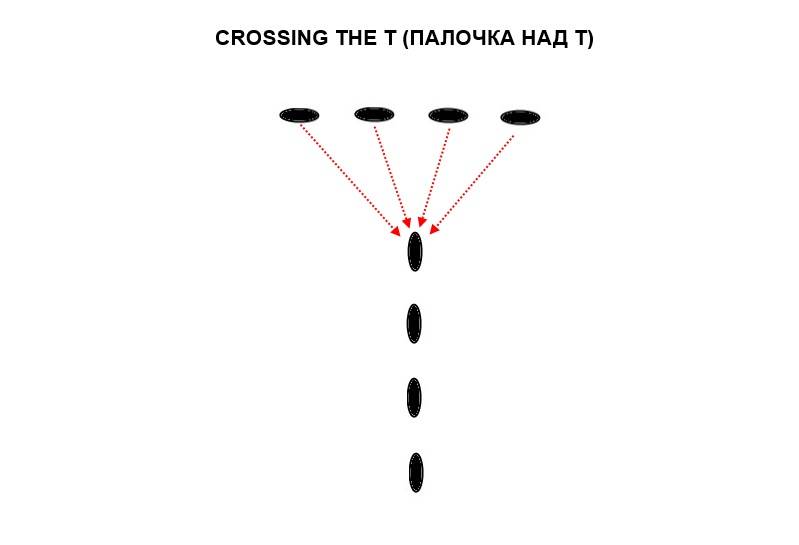
Many copies were broken on the theme of the separation from the 2 Pacific Pacific High Speed Squadron squadron of the newest battleships of the 5. But such an action would be justified only if the indicated 5 battleships, acting together, could have developed speed more than the Japanese fleet. In this case, they could really try to outplay H. Togo, compensating for their small number with an advantageous tactical position. But this, of course, was not - in the opinion of the author of this article, the best Russian battleships could not go together faster than 13-13,5 nodes, while the Japanese - 15 nodes, and more briefly. And even if we assume that the 1-th armored detachment and Oslyabya were not inferior in speed to the Japanese, it still made no sense to isolate them into a separate detachment. Having no superiority in speed, they still could not have put the "crossing the T" Japanese fleet. Thus, it would all boil down to the fact that the five best Russian ships overtook the rest of the forces and were forced to fight a dozen Japanese armored ships without the support of sluggers: The power ratio is so unequal that it "killed" the Russian squadron no worse than the notorious "Crossing the T".
The Russian commander did his best to train the ships entrusted to him to maneuver, although he did not achieve great success in this. But the NII squadron that had recently joined him. Nebogatov simply did not have time to gain experience of joint actions with the 2 Pacific. At the same time, the Japanese had flooded combat troops that had combat experience, and, apparently, were better than the Russian fleet in coordination.
The conclusion from the above is very simple. The Japanese were superior to the Russians literally in all respects: they were faster, maneuvered better, and had combat experience. Accordingly, Z.P. Rozhestvensky could, of course, build up the main forces of his squadrons in advance in the wake column, or in the front, or bearing. But none of this gave him an advantage, because the Japanese, seeing the Russian system and taking advantage of the speed, always had the opportunity to achieve a tactical victory, setting the Russian commander for that same "crossing the T".
And what do you do?
Strictly speaking, Zinovy Petrovich faced an unsolvable task in tactical terms. But, oddly enough, ZP Rozhdestvensky succeeded in this “almost hopeless situation” of “finding an entrance”. And in order not to draw more intrigue, we will immediately indicate what it was.
Since no type of military system saved the Russians from defeat, the idea of the Russian commander was to ... not accept any system. In other words, the Russian squadron should have been marching before the appearance of the enemy. Then she should wait for the maneuver of X. Togo, and when he manifests his intentions - to turn around in combat formation, depending on the decision of the Japanese commander.
The trick here was this. If ZP Rozhestvensky led the forces entrusted to him by the wake or front line, then Kh. Togo, informed in advance about the battle formation of the Russians, could calculate the correct maneuver in advance and then execute it. The wake column of the Russians would directly “ask for” a “wand over T”, but if Z.P. Rozhestvensky deployed a squadron to the front, then Kh. Togo could attack one of the flanks of the Russian squadron, still putting out "crossing the T". In other words, if Zinovy Petrovich had built his squadron in any military order, the Japanese commander would have known what he should do, and the Russian admiral would not have been able to parry the actions of his enemy. But the marching system created uncertainty, because it was clear that the Russians would turn from it into battle formation, but it was completely incomprehensible in which. Line abreast? Wake column? And where will they be sent?
In such a decision Z.P. Rozhestvensky was one, but a very significant drawback. The visibility of 14 in May was limited to 6-7 for miles and for the time it took the Russian squadron to rebuild (about 20 minutes), the Japanese could get close to the Russian ships on the 10-20 cable. In other words - there was a sufficiently significant risk that the battle would begin even before the Russian squadron had time to completely restructure. However, this could not happen, but even if it did, in this case, the Japanese benefit was still not as big as it could have been if they had succeeded in “crossing the T”.
Let us accept as a hypothesis that the plan of the Russian commander was as follows:
1. Wait for the appearance of the Japanese forces, following in the marching order.
2. Wait for the decision of H. Togo to fight. In other words, the Japanese admiral had to decide how he was going to attack the Russian squadron — try, for example, to place two columns at the same time, or attack a weaker column, or something else.
3. And only when X. Togo makes its decision, and begins to execute it, that is, it will begin the implementation of this or that maneuver, taking advantage of the fact that the execution of this maneuver will bind the Japanese commander for the next 12-15 minutes, to start such a reorganization into battle formation, in which the Russian main forces will be brought into battle in the best way.
Here we assume (again, in the form of a hypothesis) that Z.P. Rozhestvensky did not “dwell on” his plan at all: his task was not to accurately fulfill the above paragraphs, but to prevent the Japanese from gaining a tactical victory in the battle stitch.
And now, having made these assumptions, let's analyze the actions of the Russian squadron and its commander right up to the start of the battle of the main forces.
Fight with the shadow
So, at about 06.20 in the morning, Izumi shows up around the Russian squadron. Marching Russian system, in which it remains unchanged - Z.P. Rozhdestvensky waits, rightly believing that the main forces of the Japanese are not yet nearby. But then new Japanese cruisers appear - Chin-Yen, Matsushima, Itsukushima and Hassidate. This, quite possibly, indicates that a dozen battleships and armored cruisers flying the flag of the rising sun are not far away. Firstly, since the appearance of Izumi, 3 hours have passed, and secondly, it’s still hard to imagine that Kheykhatiro Togo will send a very slow-moving 3 battle squadron to watch the Russian squadron, being too far to have time to come to him to the rescue.
And then the Russian commander begins rebuilding, but how? The right column receives an order to increase the speed to 11 nodes, while the left one continues to follow, as if nothing had happened, on 9 nodes. In other words, the rebuilding takes place very, very slowly, and even if the main forces of the Japanese fleet appeared half an hour later, and even 40 minutes, he would see that the Russians still go in two columns, that is, without rebuilding into a marching system. In other words, the gradual advancement of the right column reduced the time required for rebuilding into a combat order, but up to a certain time did not allow an outside observer to understand what this new order would be. So for a long time, the “intrigue” - how the Russian commander is going to rebuild after all - was preserved.
But time passed, but the Japanese main forces did not have everything. The right column has already almost overtaken the left, and here Z.P. Rozhestvensky build their troops in the wake of the became quite obvious. Finally, new Japanese forces appeared in 11.05, but these were not the battleships H. Togo and the armored cruisers H. Kamimura, but the “dogs” of “Chitose”, “Kasagi”, “Niytaka” and “Tsushima”.
The trick did not work, the Russian commander made a mistake: the maneuver, which was designed to reduce the rebuilding time, had to be stopped earlier, simply reducing the speed of the right column to the 9 nodes, and now it was too late. And - the appearance of "dogs" was supposed to indicate the imminent appearance of the Japanese main forces. Accordingly, there was no time to try to return the squadron to the marching system, and Z.P. Rozhdestvensky is left with the only sensible decision: to build his ships in the wake and to prepare for battle, hoping for the best.
He does this, however, in 11.15, when squadrons line up, a random shot from the Eagle provokes a short ten-minute skirmish with the Japanese cruisers, as a result of which the latter are retreating. However, the Japanese continue to monitor the Russian squadron. In 11.25, the skirmish is over, but 15 minutes go by, 20 - and the main forces of Kheyhatiro Togo as it was not, and no. At this time, it is just time to turn to the course leading to Vladivostok - to the north. Z.P. Rozhdestvensky does just that, but there are also Japanese cruisers that continue to monitor the squadron. Seeing that the Russian column was turning on them, the scouts retreated and for some time lost our ships from view.
And here Z.P. Rozhestvensky again makes an attempt to outwit the Japanese. All this time, their cruisers, watching the Russians, were north of the Russian system, from which it can be concluded that the main forces of the Japanese are coming from the north. It was logical, in particular, in terms of the locations of the Japanese fleet. The Russian commander waited for them to appear at any moment and decided to continue the “shadow fight”.
This time, Zinovy Petrovich, obviously, argued as follows: the "dogs" and the 3 combat detachment would obviously inform H. Togo of the course and the construction of the Russian squadron. The Japanese commander, if he is near, will know that the Russian squadron is marching in line with NO23. Then, using unimportant visibility, he may try to “crossing the T” to the head ships of Z.P. Rozhdestvensky. So why not try to surprise Heyhatiro Togo and rebuild the front?
Here is how Zinovy Petrovich himself described it:
In other words, the Russian commander tried to prepare a surprise for the Japanese.
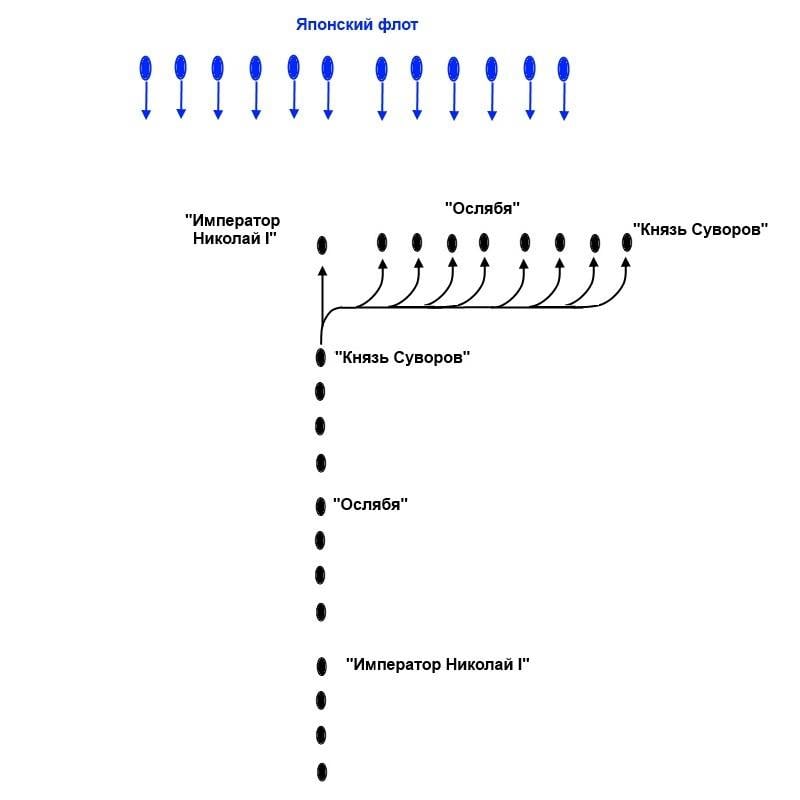
Which, however, failed, because at the moment of execution of the maneuver the Japanese cruisers again appeared
In other words, another trick of Z.P. Rozhdestvensky disappeared in vain - instead of the main forces, he again saw only Japanese cruisers in front of him and further rebuilding of the front lost all meaning. If X. Togo is really building the front from the north, and learns in advance that the main Russian forces are coming forward to meet, it will not be difficult for him to reorganize into a wake column and attack the flank of the Russian order, setting "crossing the T".
And then Z.P. Rozhestvensky returns to his original plan:
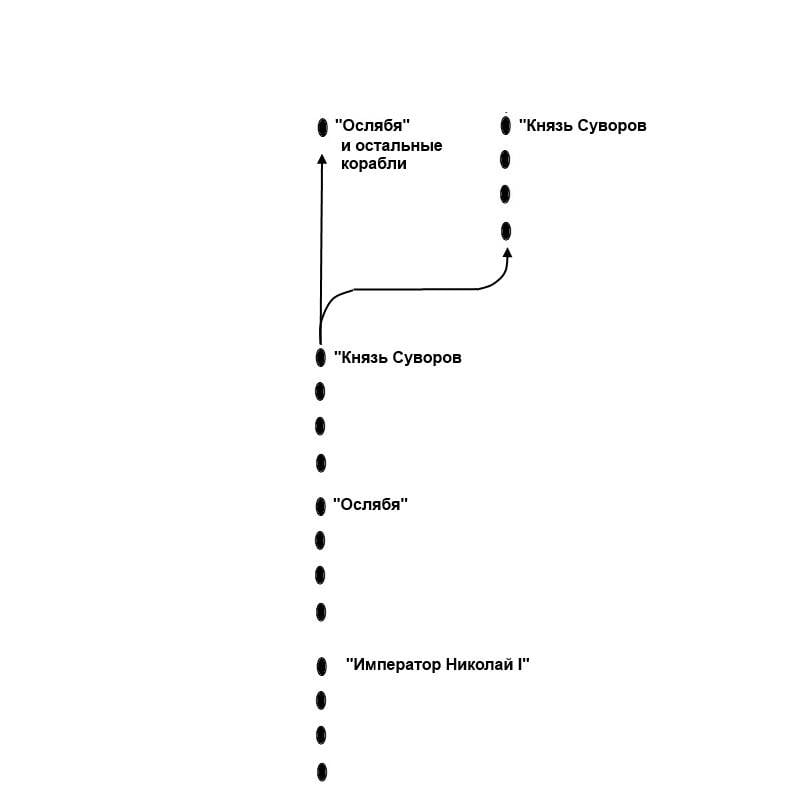
As a result, the Russian squadron was again divided into 2 columns of armored ships, but now in the right column there was only the 1th armored squad, that is, 4 squadron battleships of the “Prince Suvorov” type.
It must be said that this description of the maneuver was made from the words of the commander, but there are other opinions. So, the junior flag officer Z.P. Rozhdestvensky midshipman Demchinsky described this episode differently:
Who is right? The members historical the commissions that made up the Russo-Japanese War of 1904-1905 assert that it was ZP who was right. Rozhdestvensky, based on the fact that, in fact, on the “back mast” were not raised a signal about the turn “suddenly” and the flag “P”, but the call signs of the 2nd detachment and the signal “F” (canceling), which is confirmed by the logbook “ Pearls. " In addition, the testimony of a number of squadron officers confirms the words of Zinovy Petrovich. So, for example, Lieutenant Slavinsky reported:
It is interesting that the version of the commander of the Russian squadron was confirmed even by such an ardent opponent of Z.P. Rozhestvensky, as A.S. Novikov-Surf:
Why did the author spend so much time parsing this maneuver? The fact is that Demchinsky’s opinion turned out to be quite widespread. Many interested in the history of the fleet sincerely believe that Z.P. Rozhdestvensky really intended to build his squadron with the letter “G”, where a horizontal stick would be formed by the 4 battleship of the Suvorov and Oslyabya type, and a vertical one would be formed by the same Oslyabya and the ships of the 2 and 3 armored detachments following it. Such a “battle formation”, of course, was no good, since both “sticks” of the Russian system would be too weak to withstand the attack of the Japanese fleet. But, as we see, the Russian commander didn’t do anything like that.
“Good,” the respected reader will say: “But if Z.P. Rozhdestvensky did not succeed, and the squadron was divided into 2 columns for objective reasons, then why would the commander not immediately correct this misunderstanding, and not build the main forces of the squadron again into a single wake formation? ” The answer to this question is very simple: Zinovy Petrovich was convinced that such a squadron construction gave him tactical advantages, which neither the front system nor the wake column would have. Here is how he explained the advantages of such a construction of the Investigation Commission:
In other words, Z.P. Rozhestvensky built his main forces in a seemingly completely confused, non-combat system. But this is only at first glance - in fact, the separation of the 1 armored detachment into a separate column gave the Russians a huge advantage: it practically nullified the tactical advantages of the Japanese, which they had before the outset of the battle.
As a matter of fact, H. Togo, seeing such a structure of the Russian squadron, faced a choice: he could either try to put a "crossing the T" on both columns of the Russian battleships, or attack the left or right columns in the wake formation, diverging from them on countercourses.
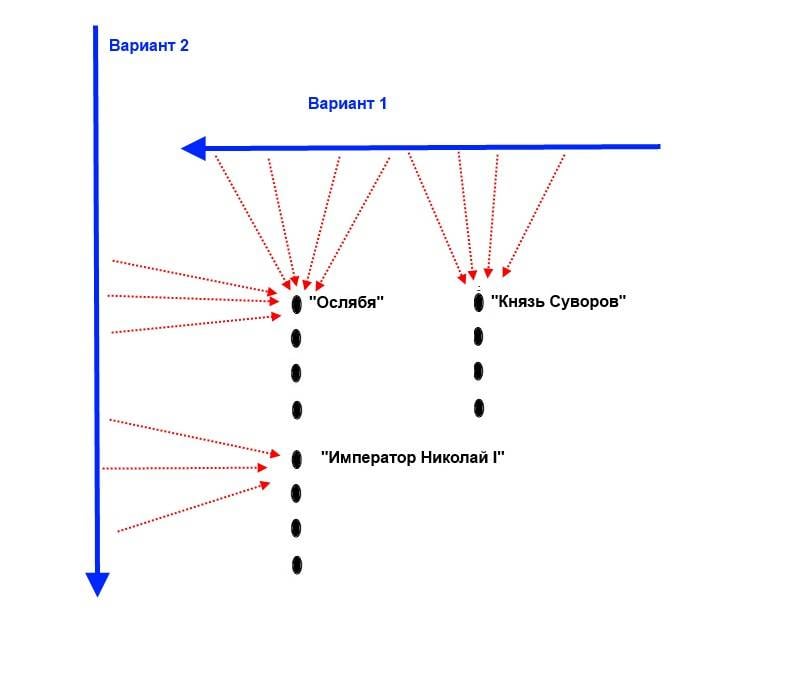
But, moving in two wake columns, Z.P. Rozhestvensky could successfully parry any of these options, because he could rebuild his forces into the front or the wake very quickly. The thing is that to rebuild from a conventional wake column to the front, at least 1 and 2 units would take Z.P. Rozhdestvensky, at the speed of 9 nodes, is no less than 12 minutes, because the turning point would have passed 8 ships stretching for 2 miles. But moving in two parallel columns, the 1 th and 2 th combat detachments turned into a front almost twice as fast, slightly more than in 5 minutes, since in this case the 1 th and 2 th units would be deployed at the same time rather than consistently.
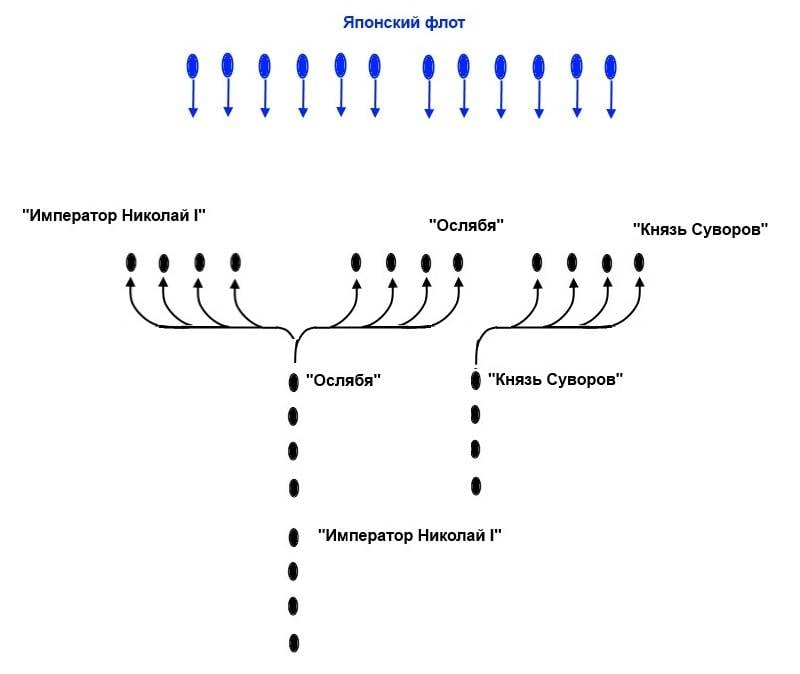
Perhaps if the Japanese tried to attack "at full speed", the Nebogatov 3 squad wouldn’t have time to turn around, but even in this case the 8 ships of the 1 and 2 squads would meet the Japanese, as well as approaching the turning point "Emperor Nicholas I".
And the same can be said about rebuilding into a wake column. If, moving in the marching order, Z.P. Rozhdestvensky had to move the right column of 2 combat units, including the relatively slow-moving Admiral Nakhimov, Navarin and Sisoy the Great, then in a new position - only the relatively high-speed four battleships of the Borodino type.
But the reverse rebuilding into the wake column was associated with certain risks. But, unfortunately, the story of this will have to be postponed until the next article.
To be continued ...
- Andrei from Chelyabinsk
- Jewels of the Russian Imperial Navy. Pearls and Emerald
Jewels of the Russian Imperial Navy. "Pearls" and "Emerald". Design features
Jewels of the Russian Imperial Navy. "Pearls" and "Emerald". About the quality of construction
Jewels of the Russian Imperial Navy. "Pearls" and "Emerald". Libava - Madagascar
Jewels of the Russian Imperial Navy. "Pearls" and "Emerald". Madagascar - Tsushima
Why ZP Rozhdestvensky did not use the cruiser "Pearl" and "Emerald" in Tsushima for the intended purpose?
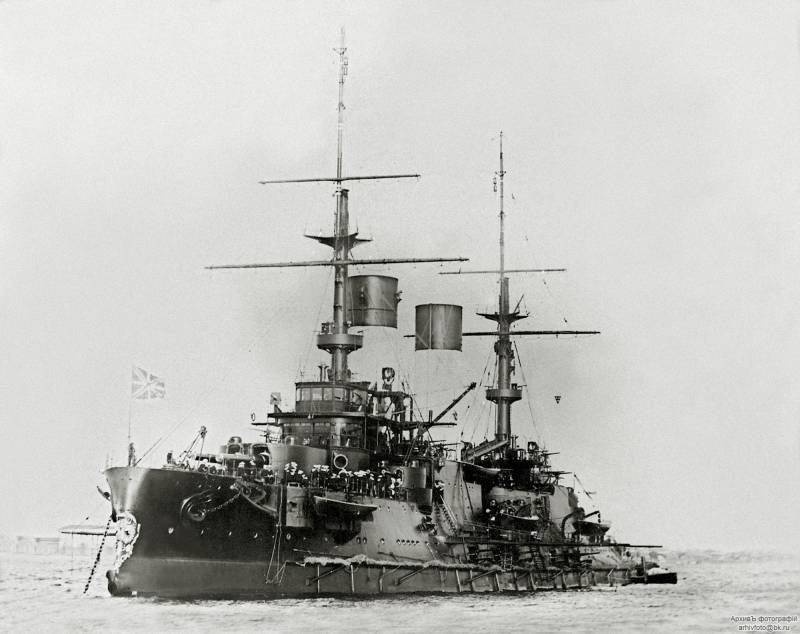
Information